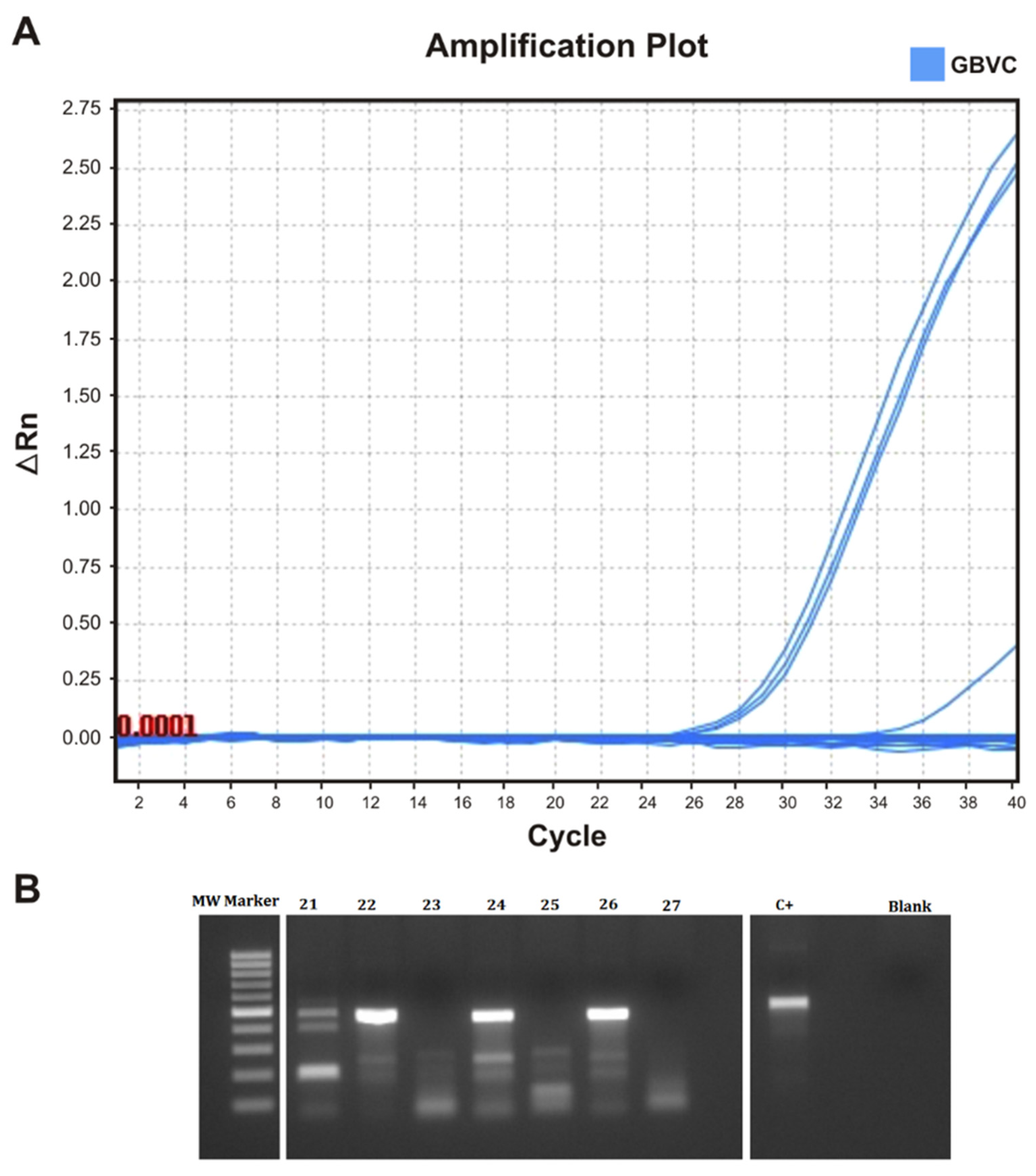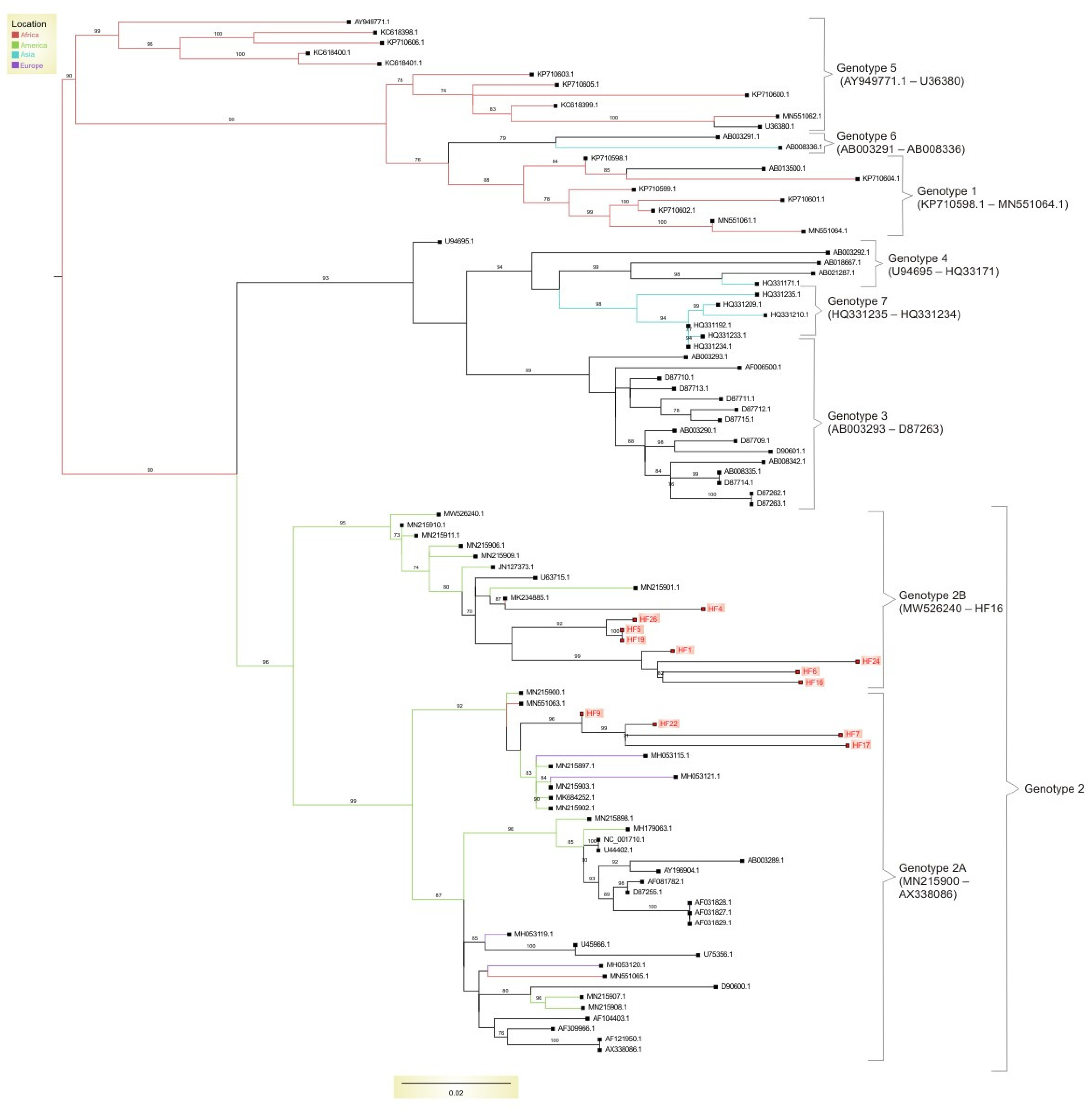Human Pegivirus-1 Detection and Genotyping in Brazilian Patients with Fulminant Hepatitis
Abstract
:1. Introduction
2. Materials and Methods
2.1. HPgV-1 RNA Detection Using Real-Time PCR
2.2. HPgV-1 Genotyping of the 5′ Untranslated Region (5′-UTR)
2.3. Phylogenetic Analysis
3. Results
4. Discussion
5. Conclusions
Supplementary Materials
Author Contributions
Funding
Institutional Review Board Statement
Informed Consent Statement
Data Availability Statement
Acknowledgments
Conflicts of Interest
References
- Grek, A.; Arasi, L. Acute Liver Failure. AACN Adv. Crit. Care 2016, 4, 420–429. [Google Scholar] [CrossRef]
- Larson, A.M.; Polson, J.; Fontana, R.J.; Davern, T.J.; Lalani, E.; Hynan, L.S.; Reisch, J.S.; Schiødt, F.V.; Ostapowicz, G.; Shakil, A.O.; et al. Acetaminophen-induced acute liver failure: Results of a United States multicenter, prospective study. Hepatology 2005, 42, 1364–1372. [Google Scholar] [CrossRef] [PubMed]
- Davern, T.J., 2nd; James, L.P.; Hinson, J.A.; Polson, J.; Larson, A.M.; Fontana, R.J.; Lalani, E.; Munoz, S.; Shakil, A.O.; Lee, W.M. Measurement of serum acetaminophen-protein adducts in patients with acute liver failure. Gastroenterology 2006, 130, 687–694. [Google Scholar] [CrossRef] [PubMed]
- Gatselis, N.K.; Zachou, K.; Koukoulis, G.K.; Dalekos, G.N. Autoimmune hepatitis, one disease with many faces: Etiopathogenetic, clinico-laboratory and histological characteristics. World J. Gastroenterol. 2015, 21, 60–83. [Google Scholar] [CrossRef]
- Schiødt, F.V.; Davern, T.J.; Shakil, A.O.; McGuire, B.; Samuel, G.; Lee, W.M. Viral hepatitis-related acute liver failure. Am. J. Gastroenterol. 2003, 98, 448–453. [Google Scholar] [CrossRef] [PubMed]
- Lin, S.; Zhang, Y.J. Advances in Hepatitis E Virus Biology and Pathogenesis. Viruses 2021, 13, 267. [Google Scholar] [CrossRef]
- Samadi, M.; Salimi, V.; Haghshenas, M.R.; Miri, S.M.; Mohebbi, S.R.; Ghaemi, A. Clinical and molecular aspects of human pegiviruses in the interaction host and infectious agent. Virol. J. 2022, 19, 41. [Google Scholar] [CrossRef]
- Deinhardt, F.; Holmes, A.W.; Wolfe, L.; Junge, U. Transmission of viral hepatitis to nonhuman primates. Vox Sang. 1970, 19, 261–269. [Google Scholar] [CrossRef]
- Silva, A.S.N.; Silva, C.P.; Barata, R.R.; da Silva, P.V.R.; Monteiro, P.D.J.; Lamarão, L.; Burbano, R.M.R.; Nunes, M.R.T.; de Lima, P.D.L. Human pegivirus (HPgV, GBV-C) RNA in volunteer blood donors from a public hemotherapy service in Northern Brazil. Virol. J. 2020, 17, 153. [Google Scholar] [CrossRef]
- Castro, M.; Matas, I.M.; Silva, E.; Barradas, P.F.; Amorim, I.; Gomes, H.; Monteiro, Á.; Nascimento, M.S.J.; Mesquita, J.R. Occurrence and molecular characterization of human pegivirus-1 (HPgV-1) viremia in healthy volunteer blood donors from Northern Portugal. J. Med. Virol. 2022, 94, 3442–3447. [Google Scholar] [CrossRef]
- Pradier, A.; Cordey, S.; Zanella, M.C.; Melotti, A.; Wang, S.; Mamez, A.C.; Chalandon, Y.; Masouridi-Levrat, S.; Kaiser, L.; Simonetta, F.; et al. Human pegivirus-1 replication influences NK cell reconstitution after allogeneic haematopoietic stem cell transplantation. Front. Immunol. 2023, 13, 1060886. [Google Scholar] [CrossRef] [PubMed]
- Vimali, J.; Yong, Y.K.; Murugesan, A.; Ashwin, R.; Balakrishnan, P.; Raju, S.; Velu, V.; Larsson, M.; Shankar, E.M. Surrogate Biomarkers of Disease Progression in Human Pegivirus Seropositive Human Immunodeficiency Virus-Infected Individuals. Viral Immunol. 2023, 36, 55–62. [Google Scholar] [CrossRef] [PubMed]
- Souza, I.E.; Allen, J.B.; Xiang, J.; Klinzman, D.; Diaz, R.; Zhang, S.; Chaloner, K.; Zdunek, D.; Hess, G.; Williams, C.F.; et al. Effect of primer selection on estimates of GB virus C (GBV-C) prevalence and response to antiretroviral therapy for optimal testing for GBV-C viremia. J. Clin. Microbiol. 2006, 44, 3105–3113. [Google Scholar] [CrossRef]
- Kriesel, J.D.; Hobbs, M.R.; Jones, B.B.; Milash, B.; Nagra, R.M.; Fischer, K.F. Deep sequencing for the detection of virus-like sequences in the brains of patients with multiple sclerosis: Detection of GBV-C in human brain. PLoS ONE 2012, 7, e31886. [Google Scholar]
- Miao, Z.; Gao, L.; Song, Y.; Yang, M.; Zhang, M.; Lou, J.; Zhao, Y.; Wang, X.; Feng, Y.; Dong, X.; et al. Prevalence and Clinical Impact of Human Pegivirus-1 Infection in HIV-1-Infected Individuals in Yunnan, China. Viruses 2017, 9, 28. [Google Scholar] [CrossRef] [PubMed]
- Katoh, K.; Standley, D.M. MAFFT multiple sequence alignment software version 7: Improvements in performance and usability. Mol. Biol. Evol. 2013, 30, 772–780. [Google Scholar] [CrossRef] [PubMed]
- Larsson, A. AliView: A fast and lightweight alignment viewer and editor for large datasets. Bioinformatics 2014, 30, 3276–3278. [Google Scholar] [CrossRef] [PubMed]
- Nguyen, L.T.; Schmidt, H.A.; von Haeseler, A.; Minh, B.Q. IQ-TREE: A fast and effective stochastic algorithm for estimating maximum-likelihood phylogenies. Mol. Biol. Evol. 2015, 32, 268–274. [Google Scholar] [CrossRef]
- Rambaut, A. FigTree v1.3.1. Institute of Evolutionary Biology, University of Edinburgh, Edinburgh. Available online: http://tree.bio.ed.ac.uk/software/figtree (accessed on 1 April 2023).
- Kumar, D.; Gupta, R.K.; Anand, R.; Pasha, S.T.; Rai, A.; Das, B.C.; Kar, P. Occurrence and nucleotide sequence analysis of hepatitis G virus in patients with acute viral hepatitis and fulminant hepatitis. Indian. J. Med. Res. 2007, 125, 752–755. [Google Scholar]
- Cao, M.M.; Ren, H.; Zhao, P.; Pan, W.; Chen, Q.L.; Qi, Z.T. Persistent replication of the GBV-C subgenomic replicons in Huh7 cells. J. Virol. Methods 2009, 157, 168–174. [Google Scholar] [CrossRef]
- Valença, I.N.; Rós, F.A.; Zucherato, V.S.; Silva-Pinto, A.C.; Covas, D.T.; Kashima, S.; Slavov, S.N. Comparative metavirome analysis in polytransfused patients. Braz. J. Med. Biol. Res. 2021, 54, e11610. [Google Scholar] [CrossRef] [PubMed]
- Yang, N.; Dai, R.; Zhang, X. Global prevalence of human pegivirus-1 in healthy volunteer blood donors: A systematic review and meta-analysis. Vox Sang. 2020, 115, 107–119. [Google Scholar] [CrossRef] [PubMed]
- Simons, J.N.; Leary, T.P.; Dawson, G.J.; Pilot-Matias, T.J.; Muerhoff, A.S.; Schlauder, G.G.; Desai, S.M.; Mushahwar, I.K. Isolation of novel virus-like sequences associated with human hepatitis. Nat. Med. 1995, 1, 564–569. [Google Scholar] [CrossRef] [PubMed]
- Sarrazin, C.; Roth, W.K.; Zeuzem, S. GB-Virus-C/Hepatitis-G-Virus--Entdeckung, Epidemiologie, Diagnostik und klinische Relevanz. Z. Gastroenterol. 1998, 36, 997–1008. [Google Scholar] [PubMed]
- Yu, Y.; Wan, Z.; Wang, J.H.; Yang, X.; Zhang, C. Review of human pegivirus: Prevalence, transmission, pathogenesis, and clinical implication. Virulence 2022, 13, 324–341. [Google Scholar] [CrossRef] [PubMed]
- Zhang, W.; Chaloner, K.; Tillmann, H.; Williams, C.; Stapleton, J. Effect of early and late GB virus C viraemia on survival of HIV-infected individuals: A meta-analysis. HIV Med. 2006, 7, 173–180. [Google Scholar] [CrossRef] [PubMed]
- Giret, M.T.M.; Kallas, E.G. GBV-C: State of the Art and Future Prospects. Curr. HIV/AIDS Rep. 2012, 9, 26–33. [Google Scholar] [CrossRef]
- Bhattarai, N.; Stapleton, J.T. GB virus C: The good boy virus? Trends Microbiol. 2012, 20, 124–130. [Google Scholar] [CrossRef]
- Zimmerman, J.; Blackard, J.T. Human pegivirus type 1 infection in Asia-A review of the literature. Rev. Med. Virol. 2022, 32, 1–18. [Google Scholar] [CrossRef]
- Niama, R.F.; Mayengue, P.I.; Nsoukoula, B.C.M.; Koukouikila-Kossounda, F.; Badzi, C.N.; Mandiangou, A.F.; Louzolo, I.; Fila-Fila, G.P.U.; Dossou-Yovo, L.R.; Angounda, M.B. Genetic variability of human pegivirus type 1 (HPgV-1) among Congolese co-infected with hepatitis C virus in Brazzaville, Congo. IJID Reg. 2023, 21, 191–192. [Google Scholar] [CrossRef]
- Slavov, S.N.; Maraninchi Silveira, R.; Hespanhol, M.R.; Sauvage, V.; Rodrigues, E.S.; Fontanari Krause, L.; Bittencourt, H.T.; Caro, V.; Laperche, S.; Covas, D.T.; et al. Human pegivirus-1 (HPgV-1) RNA prevalence and genotypes in volunteer blood donors from the Brazilian Amazon. Transfus. Clin. Biol. 2019, 26, 234–239. [Google Scholar] [CrossRef] [PubMed]
- Jõgeda, E.L.; Huik, K.; Pauskar, M.; Kallas, E.; Karki, T.; Des Jarlais, D.; Uusküla, A.; Lutsar, I.; Avi, R. Prevalence and genotypes of GBV-C and its associations with HIV infection among persons who inject drugs in Eastern Europe. J. Med. Virol. 2017, 89, 632–638. [Google Scholar] [CrossRef] [PubMed]
- Branco, C.; Esteves, A.; Piedade, J.; Parreira, R. A new genotype 2 subcluster identified among GBV-C strains circulating in the Lisbon metropolitan area of Portugal. J. Med. Virol. 2010, 82, 452–459. [Google Scholar] [CrossRef] [PubMed]
- Dos Santos Bezerra, R.; Santos, E.V.; Maraninchi Silveira, R.; Silva Pinto, A.C.; Covas, D.T.; Kashima, S.; Slavov, S.N. Molecular prevalence and genotypes of human pegivirus-1 (HPgV-1) and SENV-like viruses among multiply transfused patients with beta-thalassemia. Transfus. Apher. Sci. 2020, 59, 102697. [Google Scholar] [CrossRef]
- Slavov, S.N.; Silveira, R.M.; Rodrigues, E.S.; Diefenbach, C.F.; Zimmermann, A.M.; Covas, D.T.; Kashima, S. Human pegivirus-1 (HPgV-1, GBV-C) RNA prevalence and genotype diversity among volunteer blood donors from an intra-hospital hemotherapy service in Southern Brazil. Transfus. Apher. Sci. 2019, 58, 174–178. [Google Scholar] [CrossRef] [PubMed]


| Sample ID | Amplification Results | ||
|---|---|---|---|
| Nested-PCR | RT-PCR | Cycle Threshold | |
| HF01 | + | - | NA * |
| HF04 | + | + | 23.6 |
| HF05 | + | + | 23.1 |
| HF06 | + | - | NA * |
| HF07 | + | - | NA * |
| HF09 | + | + | 24.3 |
| HF16 | + | - | NA * |
| HF17 | + | - | NA * |
| HF19 | + | + | 31.5 |
| HF22 | + | - | NA * |
| HF24 | + | - | NA * |
| HF26 | + | - | NA * |
Disclaimer/Publisher’s Note: The statements, opinions and data contained in all publications are solely those of the individual author(s) and contributor(s) and not of MDPI and/or the editor(s). MDPI and/or the editor(s) disclaim responsibility for any injury to people or property resulting from any ideas, methods, instructions or products referred to in the content. |
© 2023 by the authors. Licensee MDPI, Basel, Switzerland. This article is an open access article distributed under the terms and conditions of the Creative Commons Attribution (CC BY) license (https://creativecommons.org/licenses/by/4.0/).
Share and Cite
da Silva, A.S.; de Campos, G.M.; Villanova, M.G.; Bezerra, R.d.S.; Santiago, L.M.M.; Haddad, R.; Covas, D.T.; Giovanetti, M.; Alcantara, L.C.J.; Elias, M.C.; et al. Human Pegivirus-1 Detection and Genotyping in Brazilian Patients with Fulminant Hepatitis. Pathogens 2023, 12, 1122. https://doi.org/10.3390/pathogens12091122
da Silva AS, de Campos GM, Villanova MG, Bezerra RdS, Santiago LMM, Haddad R, Covas DT, Giovanetti M, Alcantara LCJ, Elias MC, et al. Human Pegivirus-1 Detection and Genotyping in Brazilian Patients with Fulminant Hepatitis. Pathogens. 2023; 12(9):1122. https://doi.org/10.3390/pathogens12091122
Chicago/Turabian Styleda Silva, Anielly Sarana, Gabriel Montenegro de Campos, Marcia Guimarães Villanova, Rafael dos Santos Bezerra, Luciana Maria Mendes Santiago, Rodrigo Haddad, Dimas Tadeu Covas, Marta Giovanetti, Luiz Carlos Junior Alcantara, Maria Carolina Elias, and et al. 2023. "Human Pegivirus-1 Detection and Genotyping in Brazilian Patients with Fulminant Hepatitis" Pathogens 12, no. 9: 1122. https://doi.org/10.3390/pathogens12091122
APA Styleda Silva, A. S., de Campos, G. M., Villanova, M. G., Bezerra, R. d. S., Santiago, L. M. M., Haddad, R., Covas, D. T., Giovanetti, M., Alcantara, L. C. J., Elias, M. C., Sampaio, S. C., Kashima, S., & Slavov, S. N. (2023). Human Pegivirus-1 Detection and Genotyping in Brazilian Patients with Fulminant Hepatitis. Pathogens, 12(9), 1122. https://doi.org/10.3390/pathogens12091122








